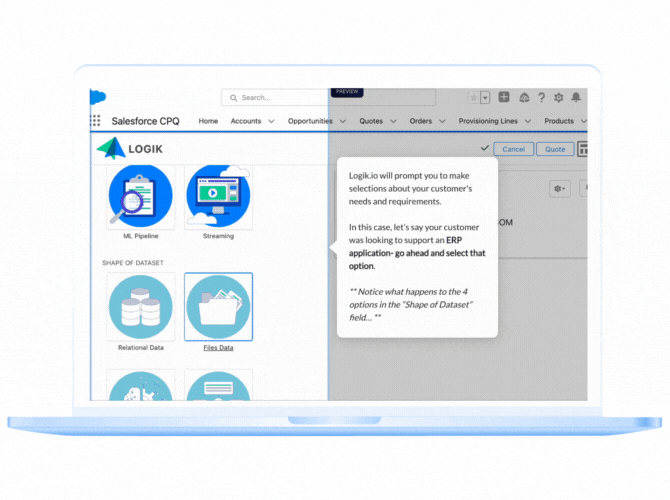Headless CPQ:
The Modern Solution for Configure Price Quote
Logik.io supercharges the "Configure" of Configure, Price, Quote, with an advanced product configurator, or as we call it, our Commerce Logic Engine, by making even the most sophisticated products simple to sell, so every customer gets exactly what they need.





How does Logik.io's Commerce Logic Engine Supercharge Your Configure, Price, Quote Experience?
Quote Line Limits?
Logik.io custom Bill of Materials object reduces quote lines needed for any configuration. Logik.io works right alongside your existing system so you can still leverage all your product data in one central place.
Performance Issues?
Logik.io’s intelligent solving engine was built to process rules and configurations with lightning speed, no matter how complex. Enable your sales reps to produce quotes faster for every product, for every customer, every time.
Complex Rules?
Logik.io’s is built with low-code and no-code admin features to handle any level of complexity, with lower admin effort. Allowing your business to maintain less and go to market faster by managing all products and data in one place.
Table of Contents
Section 1
Headless CPQ
When you think about traditional CPQ systems or eCommerce platforms, you probably imagine these large monolithic solutions that provide all-in-one capabilities.
If you use Shopify, you're basically committed to only using Shopify plugins and Shopify's technology. Your shopping cart technology and check-out technology are all built by Shopify. You either take it all or leave it all. But what if you could mix and match your favorite commerce technologies under one roof? Instead of settling for lots of little defeats for the bigger victory, you could build your dream commerce solution without any compromises.
Welcome to "headless" technology. Headless CPQ or e-commerce platforms decouple their front-end and back-end. In other words, you still get to use your favorite shiny, beautiful themes and front-end solutions. But you can integrate a wonderland of unique and awesome back-end solutions (e.g., payment gateways, inventory management, shopping carts, data processing, etc.) to give you a website that extra little splash of magic. You can use any of the wonderful APIs at your disposal to produce content, build shopping ecosystems, and manage SKUs. And you can do it across multiple platforms and for multiple different devices at the same time. Logik.io offers a perfect solution for B2B eCommerce.
It's pure flexibility!
For example, let's say you want to use Shopify to power your eCommerce store. That makes sense! Shopify is an industry Goliath, and it lets you create wonderful and beautiful websites. But what if you want some extra layers of value? Maybe you want to use commerce layer to create more dynamic order fulfillment. Or maybe you want to plug Logik's headless CPQ commerce API into Salesforce to handle highly-customized product configurations. With headless commerce technology, you can do just that! Through easy-to-use APIs, you can build out an incredibly dynamic and powerful back-end without committing to insanely complex customer web development.
HEADLESS COMMERCE VS TRADITIONAL COMMERCE PROS AND CONS
Headless commerce pros:
- Build incredibly dynamic websites without significant coding
- Can use the front-end of platforms like Shopify without committing to only using Shopify's back-end capabilities
- Allows you to create incredibly dynamic websites
- Enables IoT
- Allows for dynamic pricing
Headless commerce cons:
- Requires small time commitment for setup
- Not perfect for every business
Traditional commerce pros:
- Incredibly easy and straightforward
- Use one solution and forget about it
Traditional commerce cons:
- Stuck with limited capabilities
- Can't utilize bleeding-edge solutions
Section 2 Top Headless Commerce Platforms
The current iteration of headless commerce is relatively new.
There are a few incumbent platforms (mostly existing enterprise-scale solutions) that have readily adopted headless. Most of these platforms are currently leading the charge. Below, we discuss some of the startups in this space. But, for now, let's focus on the current 3 best headless e-commerce platforms in 2022.
It’s no surprise that Shopify is the largest and probably most overall powerful headless commerce solution on the market. You have to upgrade to Plus to use Hydrogen — Shopify's headless commerce React-based framework for front-end development — and Oxygen, which is for the back-end. Both Hydrogen and Oxygen are simple to use and powerful. This is probably the most mature headless solution. But the next one on our list is also relatively mature.
By far the largest PHP headless commerce solution, Magento (now Adobe Commerce) has plenty of unique draws. In particular, it stays tried and true to its open-source beginnings. While you do have to pay for Magento Enterprise, the platform makes it extremely easy to connect your back-end to a variety of APIs. You can find plenty of free, open-source headless commerce GitHub projects and you can use headless commerce React scripts to build out powerful front-end themes. If you're in the mood for "from-scratch" solutions, pairing React and node.js gives you plenty of flexibility to create pretty dynamic commerce engines.
Like others on this list, CommerceTools offers headless commerce. And they use PHP and MySQL like Magento. But, they have one minor drawback, both Shopify and Magento have established front-end technologies. CommerceTools is more of a framework. You need to build out the front end. Otherwise, this is a fantastic and agile solution. If you're moving from something like Oracle for your enterprise, this will seem like a cakewalk in comparison. However, it's a little less robust and intuitive than Shopify.
Section 3 Headless Commerce Examples
Before we jump into some headless commerce examples, let's look at a few headless commerce statistics to help you understand the raw power of the headless ecosystem.
For starters, omnichannel (i.e., using multiple channels to sell, market, and deliver goods) is associated with a 250% bump in purchase frequency (data from Omnisend). Since headless commerce gives you the flexibility to quickly tackle multiple channels, you can tap into this massive profit pool. Better yet, having a decoupled back-end allows you to iterate changes faster. Amazon's move to their cloud platform (AWS) allowed them to increase their deployment rate to once every 11.7 seconds. Yeah, that's fast!
But what does this look like in action? Let's look at Nike's headless commerce site. They went from having a monolithic structure that barely supported mobile purchasing to having multiple unique back-ends that all connect to their front-end, allowing them to eat into their competitors like Adidas. Or, think about McDonalds, GMC, Pier1 Imports, and Volvo — all of which use the Fabric headless commerce platform to build out dynamic and jaw-dropping websites. There are plenty more examples, but the main point is this: most commerce leaders have switched to headless, and for good reason. It's faster, more flexible, and capable of providing omnichannel support to customers across the globe. You get access to thousands of top-notch headless ecommerce APIs to help you build truly unique and powerful websites.
Section 4 Headless Commerce Architecture
Okay, so what's happening behind it all?
How does headless commerce architecture work, and how does this architecture empower those headless commerce statistics discussed above? Let's take a quick dive into headless CMS vs. headless commerce. Here's what you need to know:
- Headless commerce decouples the front-end and the back-end: This means you can use multiple front-ends with a single back-end. More importantly, you can use multiple back-ends and multiple front-ends. So, let's imagine you want to sell goods across desktop, mobile, and chatbox. In a traditional, monolithic ecosystem, you're forced to use the same tools and solutions for all of these channels. But each of these channels create different experiences. So, shouldn't your commerce platform reflect that? With headless, you can have a unique back-end powering your mobile, desktop, and chatbox solutions. That means each touchpoint is hyper-customized to both the user and the platform.
- Headless commerce allows for quicker iterations and changes: Again, instead of having this single solution, you have an API layer between your front-end and back-end. You can quickly iterate new changes to each back-end, and see their real-time impact. That means faster, smarter, and more aggressive experimentation. You can roll out new features, test new markets, and experiment with unique pages without missing a beat.
- Headless commerce is more complex by nature: It's not all sunshine. Headless commerce is more complex. You have to connect various tools via APIs and create all of these back-ends and front-ends. There are many ways to do this, and some platforms make it easier than others. Some brands go deep and leverage Node.js and React SPA to build out complex back end for front end (BFF) environments. Others may use simple tools to help them build everything out. But, either way, it's a little denser than simply signing up for Shopify and downloading a few plugins.
Section 5 Headless Commerce Shopify
Obviously, Shopify is the name that comes to mind when you think "digital commerce." So, let's dive a little deeper.
Here's a quick Shopify headless commerce guide. For starters, headless commerce on Shopify is only available for Plus members. So, headless Shopify pricing starts at $2,000 per month and scales to your sales. But, despite the semi-steep pricing, you get an incredibly developed headless solution. Oxygen and Hydrogen are both heavily supported, and you can build out complex front-end and back-end ecosystems with Shopify headless storefront APIs.
You can find Shopify headless examples on their blog. But some of the largest brands (like AllBirds) use Shopify headless to power their solutions. Obviously, you can completely customize every customer touchpoint, create dynamic websites, and embed powerful back-end solutions via an API layer. But the real benefit of using Shopify (vs other platforms) is that it stays up-to-date with the latest and greatest headless innovations. Shopify is pouring significant capital into its headless architecture. And it shows.
Section 6 Headless Commerce Startups
Quickly, let's end by discussing the wonderful wave of headless commerce startups that are exploding onto the scene.
Currently, the three major startup players in this space are Bloomreach headless commerce, Chord commerce, and Fabric headless commerce. Of these, Fabric is probably the most mature. However, both Bloomreach and Chord have plenty to offer. Both Bloomreach and Chord have a data-first approach to headless. They're API-centric and heavily geared towards commerce brands that are building out sites using tons of amazing back-end technologies. That said, both of them are fairly weak on the front-end. You will basically have to completely build out your front-end, so there is a development commitment to using these platforms.
You can learn more about these startups by searching for "headless commerce" on Gartner or "headless commerce" on TechCrunch for the latest news and dynamic comparisons. Gartner is also a great resource for headless commerce statistics, and some of the latest and most ground-breaking whitepapers on the subject.

SHARE